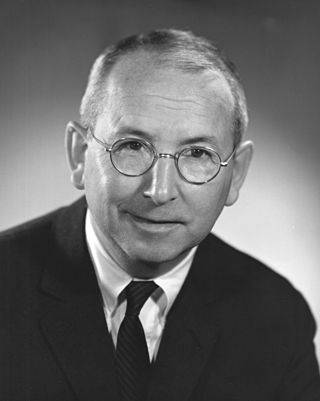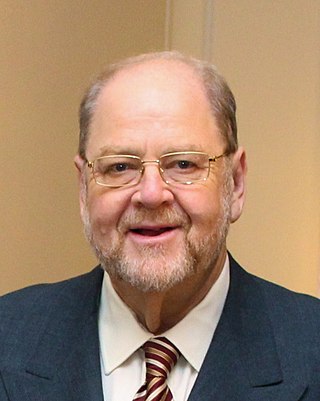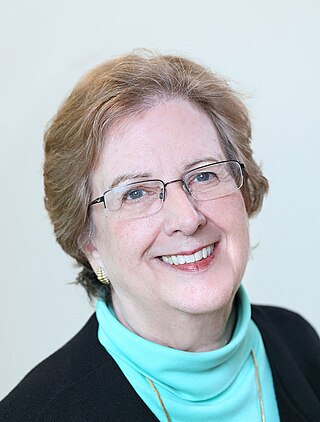
Neurology is the branch of medicine dealing with the diagnosis and treatment of all categories of conditions and disease involving the nervous system, which comprises the brain, the spinal cord and the peripheral nerves. Neurological practice relies heavily on the field of neuroscience, the scientific study of the nervous system.

Neuroscience is the scientific study of the nervous system, its functions and disorders. It is a multidisciplinary science that combines physiology, anatomy, molecular biology, developmental biology, cytology, psychology, physics, computer science, chemistry, medicine, statistics, and mathematical modeling to understand the fundamental and emergent properties of neurons, glia and neural circuits. The understanding of the biological basis of learning, memory, behavior, perception, and consciousness has been described by Eric Kandel as the "epic challenge" of the biological sciences.

Paul Donald MacLean was an American physician and neuroscientist who made significant contributions in the fields of physiology, psychiatry, and brain research through his work at Yale Medical School and the National Institute of Mental Health. MacLean's evolutionary triune brain theory proposed that the human brain was in reality three brains in one: the reptilian complex, the limbic system, and the neocortex.

James Edward Rothman is an American biochemist. He is the Fergus F. Wallace Professor of Biomedical Sciences at Yale University, the Chairman of the Department of Cell Biology at Yale School of Medicine, and the Director of the Nanobiology Institute at the Yale West Campus. Rothman also concurrently serves as adjunct professor of physiology and cellular biophysics at Columbia University and a research professor at the UCL Queen Square Institute of Neurology, University College London.

Philip E. Rubin is an American cognitive scientist, technologist, and science administrator known for raising the visibility of behavioral and cognitive science, neuroscience, and ethical issues related to science, technology, and medicine, at a national level. His research career is noted for his theoretical contributions and pioneering technological developments, starting in the 1970s, related to speech synthesis and speech production, including articulatory synthesis and sinewave synthesis, and their use in studying complex temporal events, particularly understanding the biological bases of speech and language.

Pasko Rakic is a Yugoslav-born American neuroscientist, who presently works in the Yale School of Medicine Department of Neuroscience in New Haven, Connecticut. His main research interest is in the development and evolution of the human brain. He was the founder and served as Chairman of the Department of Neurobiology at Yale, and was founder and Director of the Kavli Institute for Neuroscience. He is best known for elucidating the mechanisms involved in development and evolution of the cerebral cortex. In 2008, Rakic shared the inaugural Kavli Prize in Neuroscience. He is currently the Dorys McConell Duberg Professor of Neuroscience, leads an active research laboratory, and serves on Advisory Boards and Scientific Councils of a number of Institutions and Research Foundations.
The Gruber Prize in Neuroscience, established in 2004, is one of three international awards worth US$500,000 made by the Gruber Foundation, a non-profit organization based in Yale University in New Haven, Connecticut.

Arthur L. Horwich is an American biologist and Sterling Professor of Genetics and Pediatrics at the Yale School of Medicine. Horwich has also been a Howard Hughes Medical Institute investigator since 1990. His research into protein folding uncovered the action of chaperonins, protein complexes that assist the folding of other proteins; Horwich first published this work in 1989.
Richard Lewis Huganir is a Bloomberg Distinguished Professor in the Departments of Neuroscience and Psychological and Brain Sciences, Director of the Solomon H. Snyder Department of Neuroscience, and co-director of the Johns Hopkins Medicine Brain Science Institute at the Johns Hopkins University School of Medicine. He has joint appointments in the Department of Biological Chemistry and the Department of Pharmacology and Molecular Sciences in the Johns Hopkins School of Medicine.
The Wiley Prize in Biomedical Sciences is intended to recognize breakthrough research in pure or applied life science research that is distinguished by its excellence, originality and impact on our understanding of biological systems and processes. The award may recognize a specific contribution or series of contributions that demonstrate the nominee's significant leadership in the development of research concepts or their clinical application. Particular emphasis will be placed on research that champions novel approaches and challenges accepted thinking in the biomedical sciences.
Derek Smyth is a British biochemist who specialises in peptide structure and function. In 2002, he was admitted as a Fellow of the Royal Society of Chemistry.

Mark S. Gold is an American physician, professor, author, and researcher on the effects of opioids, cocaine, tobacco, and other drugs as well as food on the brain and behavior. He is married to Janice Finn Gold.

The Max Planck Florida Institute for Neuroscience (MPFI), is a research facility located in Jupiter, Florida. Its research focuses on brain function and neural circuits, using techniques to visualize microscopic molecular processes. It is the first institute established by the Max Planck Society in North America.

Iomazenil is an antagonist and partial inverse agonist of benzodiazepine and a potential treatment for alcohol use disorder. The compound was introduced in 1989 by pharmaceutical company Hoffmann-La Roche as an Iodine-123-labelled SPECT tracer for imaging benzodiazepine receptors in the brain. Iomazenil is an analogue of flumazenil (Ro15-1788).

Hal Blumenfeld is a Professor of Neurology, Neuroscience, and Neurosurgery at Yale University. He is an expert on brain mechanisms of consciousness and on altered consciousness in epilepsy. As director of the Yale Clinical Neuroscience Imaging Center (CNIC) he leads multi-disciplinary research and is also well known for his teaching contributions in neuroanatomy and clinical neuroscience.
Joshua R Sanes is an American neurobiologist who is known for his contributions to the understanding of synapse development. Throughout his career, Sanes has been the recipient of various awards and honors, including membership to the U.S. National Academy of Sciences. His research involves an interdisciplinary approach which focuses mainly on the formation of synapses at the neuromuscular junction by combining the sciences of psychology, chemistry, biology, and engineering to study these circuits and employ molecular and genetic imaging to understand their function. Sanes currently lives in Boston, Massachusetts with his wife, Susan, and their two children.
Nii Addy is an American neuroscientist who is an Associate Professor of Psychiatry at the Yale School of Medicine. His research considers the neurobiological basis of substance use disorders, depression, and anxiety. He has worked on various initiatives to mitigate tobacco use and addiction.
Hongkui Zeng is the Director of the Allen Institute for Brain Science in Seattle, where she leads the creation of open-access datasets and tools to accelerate neuroscience discovery. In 2011-2014 Zeng led the team that created the Allen Mouse Brain Connectivity Atlas, which indicates which regions of the mouse brain are connected to which other regions. Since then, she has led the creation of atlases of neuronal cell types in the brain of humans and mice.
David Alan McCormick is an American neurobiologist. He holds one of two Presidential chair positions and is director of the Institute of Neuroscience at the University of Oregon and co-director of the Neurons to Minds Cluster of Excellence.

Judith Richmond Walters is an American neuropharmacologist serving as chief of the neurophysiological pharmacology section at the National Institute of Neurological Disorders and Stroke.












